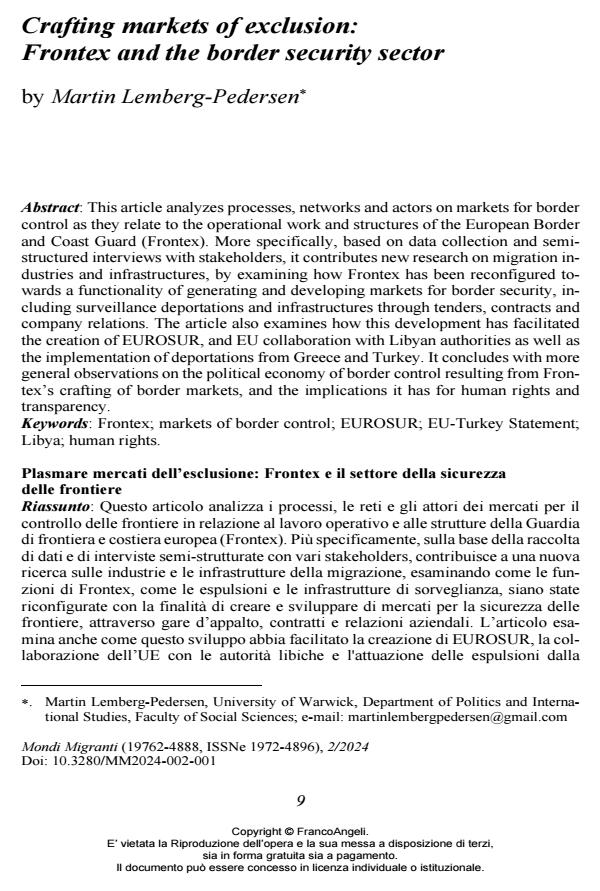Crafting markets of exclusion: Frontex and the border security sector
Titolo Rivista MONDI MIGRANTI
Autori/Curatori Martin Lemberg-Pedersen
Anno di pubblicazione 2024 Fascicolo 2024/2
Lingua Inglese Numero pagine 28 P. 9-36 Dimensione file 329 KB
DOI 10.3280/MM2024-002001
Il DOI è il codice a barre della proprietà intellettuale: per saperne di più
clicca qui
Qui sotto puoi vedere in anteprima la prima pagina di questo articolo.
Se questo articolo ti interessa, lo puoi acquistare (e scaricare in formato pdf) seguendo le facili indicazioni per acquistare il download credit. Acquista Download Credits per scaricare questo Articolo in formato PDF

FrancoAngeli è membro della Publishers International Linking Association, Inc (PILA)associazione indipendente e non profit per facilitare (attraverso i servizi tecnologici implementati da CrossRef.org) l’accesso degli studiosi ai contenuti digitali nelle pubblicazioni professionali e scientifiche
This article analyzes processes, networks and actors on markets for border control as they relate to the operational work and structures of the European Border and Coast Guard (Frontex). More specifically, based on data collection and semi-structured interviews with stakeholders, it contributes new research on migration industries and infrastructures, by examining how Frontex has been reconfigured towards a functionality of generating and developing mar-kets for border security, including surveillance deportations and infrastruc-tures through tenders, contracts and company relations. The article also exam-ines how this development has facilitated the creation of EUROSUR, and EU collaboration with Libyan authorities as well as the implementation of depor-tations from Greece and Turkey. It concludes with more general observations on the political economy of border control resulting from Frontex’s crafting of border markets, and the implications it has for human rights and transparency.
Questo articolo analizza i processi, le reti e gli attori dei mercati per il control-lo delle frontiere in relazione al lavoro operativo e alle strutture della Guardia di frontiera e costiera europea (Frontex). Più specificamente, sulla base della raccolta di dati e di interviste semi-strutturate con vari stakeholders, contri-buisce a una nuova ricerca sulle industrie e le infrastrutture della migrazione, esaminando come le funzioni di Frontex, come le espulsioni e le infrastrutture di sorveglianza, siano state riconfigurate con la finalità di creare e sviluppare di mercati per la sicurezza delle frontiere, attraverso gare d’appalto, contratti e relazioni aziendali. L’articolo esamina anche come questo sviluppo abbia faci-litato la creazione di EUROSUR, la collaborazione dell’UE con le autorità libi-che e l'attuazione delle espulsioni dalla Grecia e dalla Turchia. L’articolo si conclude con osservazioni più generali sull’economia politica del controllo delle frontiere derivante dalla gestione dei mercati di frontiera da parte di Frontex e sulle implicazioni per i diritti umani e la trasparenza.
Parole chiave:Frontex; mercati del controllo delle frontiere; EUROSUR; di-chiarazione UE-Turchia; Libia; diritti umani.
- L’IA nella gestione delle frontiere dell’Unione europea: un approccio antropocentrico per tutti? Giulia Maria Gallotta, in Community Notebook. People, Education and Welfare in the Society 5.0 7/2025 pp.341
DOI: 10.61007/QdC.2025.1.273
Martin Lemberg-Pedersen, Crafting markets of exclusion: Frontex and the border security sector in "MONDI MIGRANTI" 2/2024, pp 9-36, DOI: 10.3280/MM2024-002001